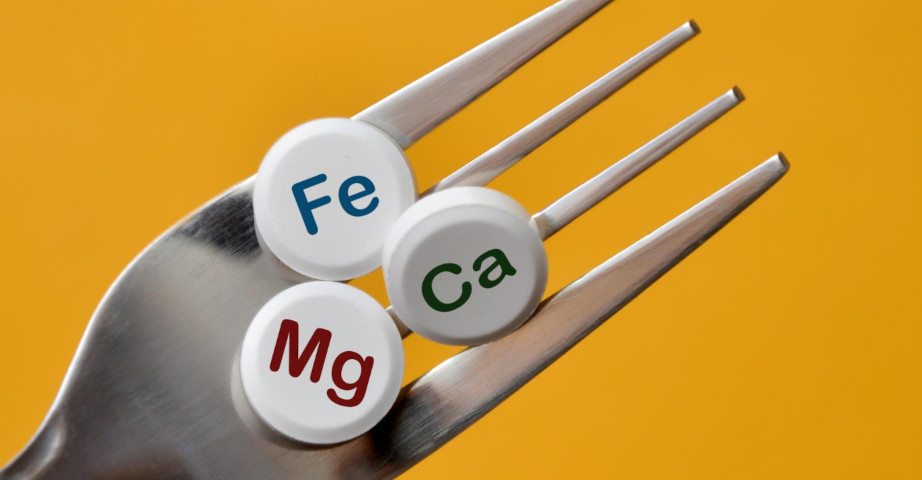Macronutrients in the human body - properties, functions, types

For the proper functioning of the human body, it is necessary to provide a number of nutrients that stimulate the growth and regeneration of cells. Among them, we can find macronutrients, or so-called major elements, which we should supply to the body in the diet or in the form of dietary supplements.
What exactly are macronutrients?
Macronutrients, also known as primary substances or major elements, are mineral constituents that occur naturally in large quantities in nature. Macronutrients can be found primarily in animal and plant organisms, and their amount varies depending on the specific environment, for example, other elements will be necessary for the proper functioning of the human body, and others in animals and plants.
In the case of humans, we usually speak of macronutrients when referring to elements whose daily requirement exceeds 100 mg. We can include them:
- nitrogen,
- chlorine,
- phosphorus,
- magnesium,
- potassium,
- sodium,
- sulphur,
- oxygen,
- calcium,
- carbon,
- hydrogen
In addition to macronutrients, we also distinguish micronutrients - these are trace elements for which the demand in the human body is much lower.
What are the functions of macronutrients?
Macronutrients are essential for the proper functioning of the human body. They perform a number of important functions that support our health. Among other things, they are an important building block of bones, teeth and tissues, ensure optimal water exchange and distribution throughout the body, participate in conditioning normal nerve excitability, and contribute to water-electrolyte balance.
Elements that are macronutrients are included in the composition of enzymes, hormones, cells and body fluids.
Micro- and macronutrients
Every cell in the body needs the right nutrients to keep it nourished. Essential elements can be divided into micro- and macronutrients, and the difference between them lies in the amount needed.
Macronutrients are components for which the human dietary requirement exceeds 100 mg per day. Micronutrients, in turn, are needed in smaller amounts. The micronutrients include iron, fluorine, iodine, manganese, molybdenum, zinc, chromium and selenium.
As in the case of macronutrients, micronutrients ensure health in our body, and their deficiencies can cause deterioration of vital functions. Some examples: chromium regulates cholesterol and energy metabolism, and deficiencies can increase the risk of cardiovascular disease, iodine supports thyroid hormones, and deficiencies can lead to diseases of this organ, while selenium protects nerve cells, and selenium deficiency can weaken immunity.
It is important to remember that excess micronutrients can be toxic and lead to many negative effects.
Recommended products
The most important macronutrients in the body
The demand in the human diet for individual macronutrients varies and depends on many factors, such as age, diet, lifestyle. A healthy and balanced diet, containing numerous sources of macronutrients, is key to maintaining health.
Calcium
Calcium is an important macronutrient that is the basic building block of bones and cartilage. It plays a very important role in the conduction of nerve impulses, as well as promoting proper blood clotting, regulating heart rhythm and participating in hormone synthesis. Calcium can also activate numerous enzymes and promote the absorption of vitamin B12.
Rich sources of naturally occurring calcium include the following foods: milk and dairy products, eggs, fish meat, almonds, hazelnuts, Brazil nuts, figs, legumes, cabbage. People who take a limited amount of these products in their diet should supplement calcium.
The daily calcium requirement is quite high at 1000 mg for children and adults and 1300 mg for the elderly and adolescents during puberty.
Phosphorus
Like calcium, phosphorus supports the health of bones and teeth, providing them with a strong structure. In addition, it participates in the metabolism of phospholipids and nucleic acids and proteins. Regulates the nervous system by supporting the proper functioning of neurons and helps maintain proper pH.
Phosphorus is primarily found in whole milk products, nuts, seeds, bran, fish meat, legumes or veal. It is also contained in pumpkin seeds and buckwheat groats. The daily requirement for phosphorus is 800 mg. Phosphorus is present in nucleic acids, cell membranes and blood.
Magnesium
Magnesium is a catalyst for numerous enzymatic reactions. This important macronutrient supports muscle and nerve function and affects heart function. May contribute to better bone mineralization. Participates in lipid metabolism.
Magnesium can be found in such products as wholegrain cereal products, buckwheat groats, legumes, nuts, pumpkin seeds, sunflower seeds, bananas, seafood, green vegetables, potatoes and cocoa. The daily magnesium requirement in an adult is 300-420 mg.
Electrolytes
Macronutrients also include potassium, sodium and chloride, which are electrolytes that support the conduction of nerve impulses and participate in the transport of water across cell membranes.
Potassium
The most important tasks of potassium in the body include regulating pH, supporting the nervous system and participating in protein synthesis. Potassium may contribute to normalizing blood pressure, as well as reducing free radicals.
Potassium can be found in such products as dried fruits, nuts, avocados, bran, groats, legumes, fish and cocoa. The body's potassium requirement is 4700 mg per day.

Sodium
Another key electrolyte in the daily diet is sodium, which, like other electrolytes, is involved in conducting nerve impulses. Its presence affects the acid-base balance and is responsible for skin tension.
The main source of sodium is common table salt. Sodium deficiency is very rare and is mainly suffered by marathon runners and laxative users. Sodium requirement is 500 mg per day and it decreases with age.
Chlorine
Chlorine affects the acid-base balance. Regulates the body's water balance, as well as blood pressure. Due to the fact that it activates digestive enzymes, it is involved in metabolism.
The main source of chlorine is table salt. It can also be found in mineral water. The daily requirement for this macronutrient is 2300 mg per day.
Macronutrient deficiency
The importance of macronutrients in daily life is significant. In highly developed countries, increasing attention is being paid to proper diet and supplementation. Despite the fact that we eat a wide variety of foods on a daily basis, there are still cases in society of diseases related to macronutrient deficiency, such as anemia and osteoporosis. At the same time, the intake of some macronutrients, such as sodium, is too high, which can also cause health risks.
Macronutrient deficiency primarily results in impaired well-being. The easiest way to fight it is to follow a balanced and conscious diet, which contains ingredients rich in a variety of macro and micronutrients. Unfortunately, a healthy diet is not always able to provide adequate levels of nutrients in the body. Certain health situations or lifestyles can limit the absorption of valuable minerals. In such cases, proper supplementation is extremely important.
The most common symptoms suggesting a deficiency of macronutrients in the body include:
- calcium: bone brittleness, uncontrollable muscle spasms, tooth loss,
- phosphorus: weakness, muscle and bone pain, tingling and numbness,
- magnesium: dizziness, fainting, sleep problems, muscle spasms,
- potassium: weakness, muscle pain, spasms, heart rhythm disturbances,
- sodium: headaches and dizziness, lack of appetite, drowsiness, fatigue,
- Chlorine: muscle weakness, spasms, convulsions, dizziness.
Macronutrient assimilation
Delivered to the body with diet or supplements, the minerals are released in the digestive tract and then enter the bloodstream. Along with the blood, they are transported to the cells and tissues of the body. Macronutrients that are not assimilated by the body are excreted in urine or feces.
Some nutrients can improve macronutrient bioavailability. The best example is vitamin D3, which supports calcium absorption. Eating a lot of fats or products containing oxalic acid can hinder the absorption of macronutrients.
Excess of macroelements
An excess of macronutrients is virtually impossible with a balanced diet. In people who consume a lot of processed foods rich in salt, it is possible to exceed sodium standards. For other macronutrients, the excess is usually associated with an overdose of supplements.
What could be the symptoms of macronutrient excess? Consuming too much calcium can lead to kidney stones, phosphorus can lead to kidney failure, magnesium can lead to heart disorders, sodium can lead to hypertension, excess potassium can lead to acidification of the body, and chlorine can lead to disorders of the neuromuscular system.
Sources:
- https://www.cdc.gov/nutrition/features/micronutrient-facts.html?CDC_AAref_Val=https://www.cdc.gov/nutrition/micronutrient-malnutrition/micronutrients/index.html
- https://www.cambridge.org/core/services/aop-cambridge-core/content/view/BC5C3044B5C56B69880F0FAA63DE5481/S0007114503002319a.pdf/totaldiet_study_dietary_intakes_of_macro_elements_and_trace_elements_in_italy.pdf
- https://www.ncbi.nlm.nih.gov/books/NBK56060/
- https://pubmed.ncbi.nlm.nih.gov/31082167/
- https://www.ncbi.nlm.nih.gov/pmc/articles/PMC5926493/
- https://medlineplus.gov/ency/article/002424.htm
